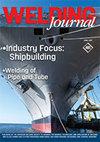X80 钢激光根焊中焊丝预热和进给量的影响:第 2 部分 - 机械性能
IF 2.2
3区 材料科学
Q2 METALLURGY & METALLURGICAL ENGINEERING
引用次数: 1
摘要
本研究的第一部分探讨了送丝速度和焊丝预热对 X80 钢激光根焊熔合区微观结构的影响。研究的第二部分揭示了冷送丝和热送丝对机械性能的影响。虽然保持了与 X80 母材的强度超配,但焊丝合金元素降低了激光熔合区上部区域的硬度,但对熔合区底部的影响有限,原因是焊点底部根部区域的填充材料与母材未完全混合。由于形成了针状铁素体微观结构,添加 ER70S-6 填充焊丝提高了焊接金属在 0°C 时的冲击韧性。当温度降至 -20°C (-4°F) 和 -45°C (-49°F) 时,出现了韧性向脆性的转变,导致焊接金属韧性降低。本文章由计算机程序翻译,如有差异,请以英文原文为准。
Effect of Wire Preheat and Feed Rate in X80 Steel Laser Root Welds: Part 2 — Mechanical Properties
In Part 1 of this study, the influences of feed rate and preheat of the wire on the fusion zone microstructure of X80 steel laser root welds were investigated. Part 2 of this study reveals the effect of cold versus hot wire feed on mechanical properties. Although strength overmatching with the X80 base metal was maintained, the wire alloying elements reduced the hardness of the upper region of the laser fusion zone but had limited effect on the bottom of the fusion zone due to the incomplete mixing of the filler material with the base metal in the bottom root region of the joint. The addition of ER70S-6 filler wire improved the impact toughness of the weld metal at 0°C, due to the formation of an acicular ferrite microstructure. As the temperature decreased to –20°C (–4°F) and –45°C (–49°F), ductile to brittle transition occurred, leading to lower weld metal toughness.
求助全文
通过发布文献求助,成功后即可免费获取论文全文。
去求助
来源期刊

Welding Journal
工程技术-冶金工程
CiteScore
3.00
自引率
0.00%
发文量
23
审稿时长
3 months
期刊介绍:
The Welding Journal has been published continually since 1922 — an unmatched link to all issues and advancements concerning metal fabrication and construction.
Each month the Welding Journal delivers news of the welding and metal fabricating industry. Stay informed on the latest products, trends, technology and events via in-depth articles, full-color photos and illustrations, and timely, cost-saving advice. Also featured are articles and supplements on related activities, such as testing and inspection, maintenance and repair, design, training, personal safety, and brazing and soldering.
 求助内容:
求助内容: 应助结果提醒方式:
应助结果提醒方式:


